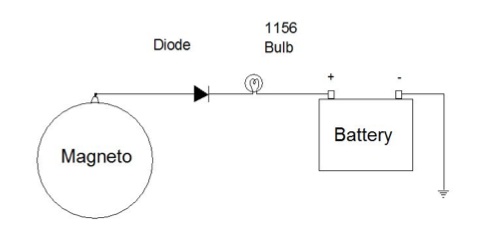|
Ford cars before the 1919 model
year did not have starters. With no electric starter
there was theoretically no need for a battery. Electric
headlights, introduced in 1915, were powered by the
magneto. But Ford was realistic enough to know that in
the real world not every magneto stays in top condition,
and sometimes might not supply enough current to the
coils for easy starting. So while the Model T was sold
without a battery, the ignition switch was designed to
use a battery for starting if the owner wanted to
install one.
Batteries used in pre-starter Fords, being aftermarket
accessories, came in a variety of shapes and sizes. Some
folks used a full sized storage battery kept in a box on
the running board. Many used the dry cell batteries that
powered telephones of that period. They were small
enough to be hidden somewhere inside the car, they
supplied enough current to buzz the coils, and they were
cheap.
|

A full size battery takes
up a lot of space, especially in a roadster. |

A small sealed battery,
easily found online, fits in much better. |
A hundred years later reality
still applies. Not all Model T magnetos are up to the
challenge of easy starting, so most owners want
batteries in their Fords. And they still face the choice
of which battery to use. Automotive storage batteries
are just as large as they were in the Model T era, and
fitting one into a T in a convenient location is a
problem if you don't have one of those running board
boxes. Dry cell phone batteries can still be had, but
are produced in much smaller numbers now and are
therefore much more expensive than they used to be. Most
folks today use small sealed batteries easily found
online. Some use twelve volts so they can run some
modern accessories, but six a volt battery will have no
trouble buzzing your coils.
Inside the frame rail is one place
for hiding a small battery.

A non-starter model T comes
without a generator of course, but the battery still
needs to be charged. Some just put a charger or a tender
on their battery between drives. With the battery being
used only to power the coils for starting, and the
switch turned to MAG for running, a single charge will
last a long time. Others install some modern geegaw like
a belt-driven alternator. But there's a cheap, easy, and
unbotrusive way to keep the batterey charged by the
magneto while the car is running. All it requires is a
bulb and socket, some wire, a diode, and a home-made
bracket to hold everything.

 WARNING! WARNING!
Be very careful which way you connect the diode. The end
with the silver stripe is the cathode and should be
connected to the 1156 bulb. The other end is the anode
and connects to the magneto. (The most convenient place
for me was at the MAG terminal of the coil box.)
Installing the diode backwards will send battery current
into the magneto and discharge the magnets. Fully
recharging them will require removing the
engine/transmission and disassembling the transmission
and magneto. |